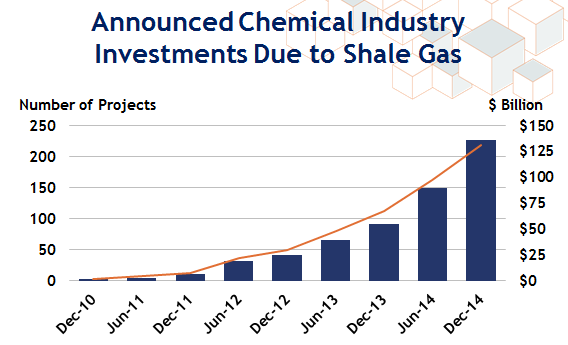On the heels of a wave of new chemical industry investment projects expected to come online over the next few years, gross exports of chemical products linked to natural gas, including plastics, could reach $123 billion by 2030 – more than double what chemical manufacturers exported in 2014, according to a new report from Nexant, Inc., and sponsored by the American Chemistry Council (ACC).
Read the Press Release: “U.S. Chemistry Exports Linked to Shale Gas Could Double by 2030, New Report Shows”
The report, “Fueling Export Growth: U.S. Net Export Trade Forecast for Key Chemistries to 2030,” is a follow-up to ACC’s “Keys to Export Growth for the Chemical Sector,” which identified several policy and regulatory changes that could facilitate billions of dollars in new export growth for the industry.
Shale gas investment precipitating surge in exports
While energy markets are dynamic, the conclusions of the report point to a long-term competitive advantage for U.S. manufacturers on shale gas-advantaged chemicals. Even with the recent drop in oil prices, the industry continues to enjoy a distinct competitive advantage in global markets (with an oil-to-natural-gas ratio of approximately 18:1).
Chemical companies have begun or are planning 223 shale-related projects, including eight announced in December, representing a cumulative investment of $137 billion, according to ACC’s latest count (February, 2015). Fully 60 percent is foreign direct investment, driven by the trio of lower-cost feedstock, reliable infrastructure and a U.S. regulatory environment that is moving toward supporting, rather than hindering, competitive success.
One of the biggest upsides from this new wave of investment is that the increased chemical capacity will unlikely be absorbed by the U.S. markets. We’re starting to see the results of this already.
Since the start of the shale gas production boon, exports of manufactured products have risen 6 percent, according to a 2014 International Monetary Fund study. China, Mexico, and other Americas are likely to remain the leading net export destinations for exports through to 2030, the Nexant report indicates.
Plastics helping to make U.S. export growth possible
With more chemistry products, including key plastics, destined for foreign shores, the industry can be a leader in helping to reduce the U.S. trade deficit while creating new economic and job-creation opportunities here at home.
Specifically, the Nexant report details how the biggest driver of the improving U.S. trade surplus will be polymers, with expected growth to nearly $22 billion in net exports by 2030.
“This is a very exciting time for the plastics industry,” said Steve Russell, vice president of plastics for the American Chemistry Council. “From exports to jobs, shale-advantaged plastics and the wide range of products they enable are poised to contribute significantly to the U.S. economy.”
Tomorrow: Delivering on the U.S. trade agenda
The massive growth potential for U.S. chemicals exports over the next 15 years does depend on several factors, including the industry’s ability to compete in the global marketplace. ACC has long-supported an ambitious trade agenda that includes robust and comprehensive trade and economic partnerships that can bridge the divide between American chemistry and overseas markets, and that can help facilitate trade movements at lower cost.
In Part Two of this exports blog series, ACC’s senior director of Regulatory and Technical Affairs, Greg Skelton, will share his thoughts on the impact U.S. trade policy can have in capitalizing on the significant boost to U.S. chemical – and broader manufacturing – competitiveness as a result of abundant, affordable shale gas.
Download the 2015 Report: “Fueling Export Growth: U.S. Net Export Trade Forecast for Key Chemistries to 2030”
Download the 2013 Report: “Keys to Export Growth for the Chemical Sector”






